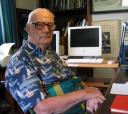Geekocracy Mourns
There have been two big losses for geekdom this month. Thanks to JLK for bringing these to my attention.
Gary Gygax
Gary Gygax, co-creator of the original fantasy role-playing game Dungeons and Dragons (D&D) back in 1973, died March 4 at the age of 69. The positive influence D&D and role playing games in general had on me, especially as a teenager, are quite profound. Gaming helped awaken a part of my intellect and imagination which, until 1980 or so, when I played my first game of D&D, was dormant. I have remarkably fond memories of many all-night gaming sessions spanning nearly 15 years from 1980 until 1994 or so through various epochs of friends and groups. Gaming also has its more pathetic and irritating elements too — elements which are largely exaggerated or misunderstood by those who haven’t done it themselves as a hobby. However, there can be no question gaming and its ubergeek culture, and thus, by association, Gary Gygax, helped influence who I am today.
Arthur C. Clarke


Also, yesterday, March 19, Arthur C. Clarke passed away at the age of 90. He was a science fiction writer and futurist, perhaps best known for his novel 2001: A Space Odyssey, which Stanely Kubrick famously adapted to film. There is a fairly complicated chicken-and-egg relationship between the novel/story and the screenplay. The film’s screenplay and story were adapted by Kubrick in collaboration with Clarke from a short story written by Clarke called The Sentinel, which was simultaneously novelized by Clarke into a separate piece of its own. Clarke used science fiction as a means to explore new fantastic, but paradoxically realistic, ideas. His work wasn’t just self-absorbed rambling or escapist fantasy, but well-crafted literary art which tried to dramatize and simulate humanity’s natural progression into the future. He predicted the existence of communication satellites in the 1940s and stimulated interest and ongoing research in the development of a space elevator. And, of course, he sparked widespread interest in AI through his characterization of HAL 9000.
I’m in no real position to write full obituaries for these two luminaries. However, I just wanted to pay my small tribute. Hat’s off to Gary Gygax, a true geek’s geek, and Arthur C. Clarke, brilliant writer and futurist. You will be missed. Fare thee well.


Never got into D&D myself. Some of the guys I was in Boy Scouts with were way into it, and it just was not something for me I determined.
Arthur Clarke, though, I did enjoy reading. 2001 was and still is a Sci-Fi classic, and HAL has to be one of the all time scary non-person characters in a film. That something so human could be construed from a red light is just brilliant and a credit to Clarke and Kubrick. Though I would have to argue that Clarke misjudged the size of the computer needed for HAL by several orders of magnitude. Realize that the original Apollo mission module had as much computing power as a present day pocket calculator.
drjohn said this on March 19th, 2008 at 7:56 am
I agree that HAL is one of the best science fiction characters of all time.
Your point about the size of HAL is well-taken. But since a super-powerful sentient machine like HAL has never actually been built, it isn’t clear how big such a machine would need to be. For scale, the “HAL room” in 2001 was comparable in size (within a factor of 2 or 3) to modern day supercomputers like IBMs Blue Gene (which, although powerful, haven’t reached the sophistication of fictional HAL…yet).
HAL was also much smaller than powerful “computing farms” used for major scientific analysis. For instance, some of the analyses I did for the STAR experiment at RHIC (an experiment on Long Island at Brookhaven), used the NERSC computing facility (photo below) in Oakland. This was basically a fairly large room full of linked PCs in a large parallel format. It was much, much bigger than HAL, but still hadn’t reached sentience — although some might say it did have psychological problems :)
Cryptohedonologist said this on March 19th, 2008 at 8:57 am
voxmoose: I’m not sure I have the hang of this but I’ll try again.
I do understand what you were saying about ‘athiests.’ I have the ability to be deep about things but sometimes my impetuousness gets in the way.
I also pay tribute to Arthur C. Clarke. I have watched 2001: A Space Odyssey many times. I’m a huge fan of HAL.
Thanks for your comment on my blog.
sue said this on March 26th, 2008 at 9:35 am
Thanks, sue. This blog has a different system than google blogger. You submit the comments and then I approve them by hand. It cuts down on spam filling up the blog. It might take upwards of a day before I get around to approving things, so don’t worry if you don’t see your comment right away.
Cryptohedonologist said this on March 26th, 2008 at 9:48 am